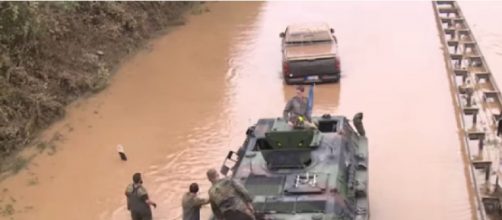Parts of Europe were in the grip of floods that took at least 189 lives and snatched the homes of tens of thousands. There was no electricity or drinking water in many places. In Germany, the floodwaters swept away entire towns, train lines and roads. That led to a breakdown in travel options and at least 158 people died. In the words of the German President Frank-Walter Steinmeier, the flooding was the worst natural disaster in a century.
CNN reports that the floods began with unprecedented rainfall in parts of western Germany. Later, the scene shifted to neighboring Belgium and the Netherlands.
The authorities of the southern Netherlands arranged largescale evacuation of residents to safety. Level of one of the rivers rose to a never-seen-before height. The rapidly rising water levels were matters of concern. Volunteers and the military worked overtime to erect flood defenses. Engineers on their part focused their attention on strengthening the embankments. The floods left behind a trail of destruction and the full impact will come to the fore when the floodwater recedes.
German Chancellor Angela Merkel visits towns hit by the floods
Schuld is one of the worst hit towns. German Chancellor Angela Merkel visited it and said the devastation was "surreal." While interacting with the media, she assured that her government would extend financial aid to the needy on priority.
Speaking alongside her, the state premier of Rhineland-Palatinate described the area as "a place of horror and destruction." Pope Francis also expressed his solidarity with the regions hit by the disaster. CNN goes on to add that the situation in Belgium was improving. The national Crisis Center explained that the search for victims continues. However, the main concern was the availability of drinking water in different areas. The death toll in the country was at least 31. Heavy downpours led to the floods and scientists are worried. They are unable to confirm whether climate change has any role to play. However, they admit that the frequency of extreme rain events, as witnessed in Western Europe this week, is on the rise.
The floods came after the heatwave in Canada and the United States
The floods in Europe come after a heatwave that scorched Canada and the United States and killed hundreds of people. Europe also was unusually hot. In fact, Helsinki, the capital of Finland, had its most scorching June on record since 1844. In the opinion of scientists, the extreme heat was a direct fallout of climate change. They explain that warmer air can hold more moisture that comes down as rain. As a professor at Leipzig University says: "When we have this heavy rainfall, then the atmosphere is almost like a sponge - you squeeze a sponge and the water flows out." Researchers continue to predict weather disruption from climate change and add that the speed with which these extremes are striking is a matter of concern.


